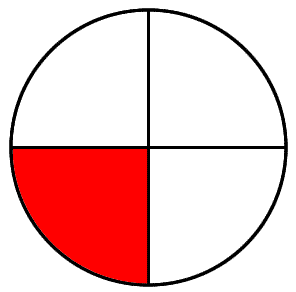| swiss-algebra-help.com |
 |
|||||
Basic Algebra Fractions
If you thing that basic algebra fractions and fraction in general are an easy concept you are far from the truth[1]. Understanding fractions requires a gradual and long learning path. Real understanding is built over time. [2] Researchers, education psychologists and even my humble direct experience teach that the concept of fraction is very poorly understood. At school but also in adults. So what is a fraction?A fraction is a proportion! Ok, but what is a proportion? A proportion is when you look at two things or group of things that you can count or measure and start comparing them: more, less, bigger, smaller, longer, shorter and so on. And that you can use numbers to express what you saw. In other words a proportion is a ratio. ..which is not an easy matter.... Let's make this revealing example.
Here is the drawing, simplified:
So basic algebra fractions are proportions: we must know what we are talking about. and specify that we mean, for instance, the same pizza not just "a" pizza. The reference counts. The size counts, too....but in relation to the whole. In other words a fraction tells us the relationship between the part and the whole. Easy? No. My children got the message, not quite the maths. That's normal. It's not self intuitive, but yes they started to be careful.... The concept of fraction is too important to let it go so quickly. Let's deepen it....here Here is a simple problem I solved on algebra.com as a tutor. The ratio of men to women at a certain company is 7 to 4. How many employees does the company have if there are 35 male employees? In which way 7men and 4women combine like 35men and "some given" women? Proportions are fractions. So 7/4=1.75 (read 7 divided by 4 equal 1.75) must be equal to 35/"some numbe"r=1.75. So what is that number? 6/"what number?"=2 which answer would it be?. Then you know that the "what number?" is 3 because you saw, intuitively,that there are 3 groups of 2 objects making a total of 6 object. In other words, you did 6/2=3. So do the same with the "more complicated" numbers of the questions. 35/"what number?"= 1.75 Now we know that there are 20 women. So in total there are 35 men and 20 women. 35+20=55 employes in total. With algebra, everything is much simplified:
we will get there.... In the example here on the left-hand side, I teach you a common trick scientists often use and that I learned from my chemistry professor at college. Simplify! If you don't know what to do with complicated numbers, use smaller numbers in the same context (e.g. 1, 2, 3, 4, etc...). My professor could compute mentally high numbers also by rounding off and simplifying and he would get a roughly correct answer, even using logarithm and squares. He was also the first ever teacher who used a "sir", courtesy form, to us (15 years old) students for the first time...I will remember him forever also for his personality which taught us things beyond chemistry. This was my college: Liceo di Mendriso, Switzerland
By the way, I found my college years more difficult than my University years... If you want you can now exercise on basic algebra fractions
other difficult concepts are subtraction (and the related division), infinity, zero.
From Basic Algebra Fractions back to the basic algebra webpage
Source: 1. Elementary and Middle School Mathematics: Teaching Developmentally (7th Edition) 2. Teaching Fractions And Ratios For Understanding: Essential Content Knowledge And Instructional...
|
On the shore of a vast sea
|
|||||
|
Stay in touch with nature. It's full of mathematics! 
Enjoy This Site?
Then why not use the button below, to add us to your favorite bookmarking service? |
||||||
|
| Homepage| About Us |Study Tips |Contact | This Website is Powered by Site Build It! - and I would never use anything else.
|
||||||
|
| ||||||



